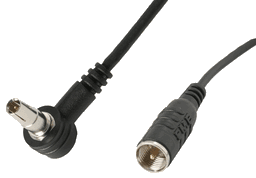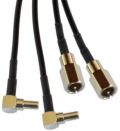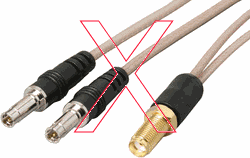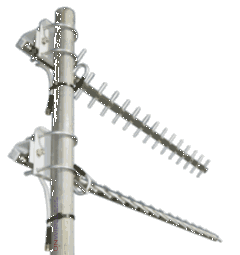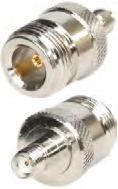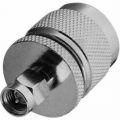Redirecting ....
|
About Mobile Broadband Antennas
-
What are Patch Cable and Passive Couplers ?
What are Patch Cable and Passive Couplers ?-
Which should I use?
2. Phone Cradles - Passive Connection
If your phone doesn't have an external antenna port then you have no choice but to use a passive coupler to improve reception.
A cradle is the best passive option, either specifically designed for a particular phone or of universal type suitable for use with many phone models.Instead of a direct connector, they couple the GSM/3G/4G phone signal by electromagnetic induction allowing the signal to travel from the cradle pad to the phones internal antenna.
Signal loss in this type of connection will be about 4-6dB for a universal cradle and about 3-4dB for model specific cradles.
3. Passive Patch Pad - Passive ConnectionIf your phone doesn't have an antenna port and no cradle is available for it, you can still improve signal by using a passive pad type patch lead.
Like the cradles, a passive-pad type patch lead has a small pad containing a coil of wire and uses the principle of electromagnetic induction to bridge the incoming signal from the pad to the phones internal antenna.Signal loss using a universal passive patch lead is about 4-6dB. The actual performance will depend on where the phones internal antenna is located and how closely the patch adaptor is coupled once installed on the phone. Given the ever-changing technology and low cost of high spec modems these days, we don't recommend using a Passive Coupler with a modem. Better to update your modem instead.
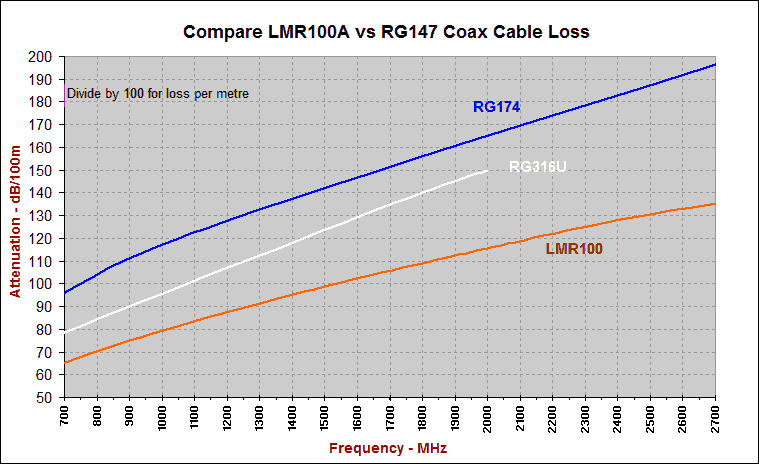
-
-
My modem has two antenna connections, do I need to connect both ?
My modem has two antenna connections, do I need to connect both ?-
Why are there two antenna sockets on my modem? When connecting a Single Antenna System to a mobile broadband modem you only need one Patch Lead. Plug the single antenna lead into the modem's MAIN Antenna Port, often marked #1. Some late model modems auto-sense the external antenna and some such as the B315 require manual selection via the web interface.
If installing a MiMo (Multiple Input Multiple Output) antenna system it will have two coax cables. Both should be plugged into the two antenna connectors of your modem. It does not matter which cable is connected to which modem port as the modem will automatically take care of the connection. A MiMo antenna consists of two antennas, one polarised at -45° and the other at +45° from vertical.
A MiMo antenna is required to achieve the higher 4G/5G data speeds. Australian MBB services use X-polarised MiMo antennas consisting of 2x antennas with 2x coax cables and thus 2x patch leads connecting to each of the two modem antenna ports.
Do you have 2-into-1 Patch Leads?
No, we don't sell theses for very good reason...
- We don't want to be responsible for damaging your modem.
- The signal strength and speed performance of your modem will be poor.These 2-into-1 patch leads are a gimmick and should never ever be used.
- No RF isolation between the two antenna ports of your modem, instead the two 50 ohm coax cables are just joined together at a single connector.- The transmitter of each modem radio is transmitting into the transceiver of the other radio. This can burn-out the transmitter or at the very least overload the RF input of the receiver. Not only that, this also prevents both ports from transmitting or receiving simultaneously, thus reducing data speeds to that of simplex mode.
- The impedance of the load to the antenna system becomes halved. These modems are designed to drive a 50ohm load. By paralleling the antenna sockets, the modem and antenna will be seeing a 25ohm load, which causes very high SWR and resultant antenna mismatch. This means that the signal strength the modem sees will be reduced by at least 3dB.
- The modem is still "seeing" just one antenna, thus will still only operate in the slower 4G SISO mode and will not take advantage of the 3G Antenna Diversity mode.
- A Further 1-3dB reduction of signal strength due to the simple physics of splitting the signal in half.
The resultant signal could be reduced by 6dB compared to using a single patch cable.
-
-
Do I need MIMO antenna or will a Single antenna do ?
Do I need MIMO antenna or will a Single antenna do ?-
Dual Antenna Systems for 4G/5G services
A single antenna will connect to 4G/5G services in "single input single output" (SISO) mode. Most 4G services in Australia are MIMO enabled, thus a Dual/MiMo type antenna will allow access to the higher data speeds available in MiMo mode.
Advantage of a MIMO antenna system
- Faster data speeds when the 4G service is MIMO enabled. (other factors may limit the real-world speed)
- More stable connectivity even in SISO mode in areas of low signal strength and/or where the signal varies with environmental conditions throughout the day, seasons and weather conditions.
- Also effective at reducing the effects of dual signal paths over water as the tide rises and falls.
Possible disadvantage of using an external antenna with mobile broadband modems
There are rare situations where an installed outdoor antenna may result in no change to, or even lower data speeds compared to just using the modem indoors. This can occur with later modems capable of Category 6 (and higher) connection protocol.
Modems such as the Netgear Nighthawk M1 use 4x4 MiMo antennas internally but have just 2 external antenna ports. External antennas will limit the connection mode to 2x2 mimo, thus only 2 data steams will be possible. It is possible that a low signal 4x4 connection can operate faster than a 2x2 connection of full signal strength.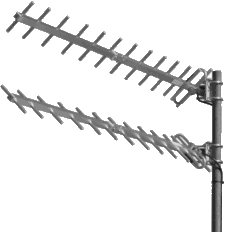
Using Dual Antenna Systems with 3G services
For all 3G services, you can install just one antenna to improve the connection.
Regardless of your modem's capability an appropriate single antenna, mounted vertically polarised will connect to 3G services. If your modem has two antenna sockets, plug the antenna system into the MAIN antenna socket (Port 1). Older 3G services cannot make use of a dual antenna system. With a single antenna the modem will run in 3G-UMTS/HSPA/WCDMA mode as available from the cell tower.Advantage of using a Dual, X-pol antenna system for 3G
- More stable connectivity in areas of low signal strength where the signal varies with environmental conditions throughout the day and/or seasons.
- Especially helpful where the signal path is obstructed by buildings or mountainous terrain.
- Also helps to reduce the effects of dual signal paths over water as the tide rises and falls.
- The modem will utilise Antenna Diversity mode, picking the best antenna signal automatically as the signal strength and polarity changes with conditions.
MIMO = "Multiple Input Multiple Output" SISO = "Single Input Single Output" DC = "Dual Carrier" AD = "Antenna Diversity"
-
-
What connection is fitted to coax cables and patch leads ?
What connection is fitted to coax cables and patch leads ?-

Our antennas and antenna coax are fitted with SMA type connectors which for some time has been the industry standard for fixed-wireless router/modems. FME connectors are also used as the final antenna connection which suits common Mobile Phone and Modem Patch Leads. Many 3G Router/Modems have SMA connectors.
We include with our antenna kits the required adaptors to provide both SMA male and FME female final termination, when a coax is ordered with the antenna.
The example to the left is a TS9 type patch cable required for many modems.
Our patch cables are supplied with an FME male connection.Some Patch Cables may include an adaptor.
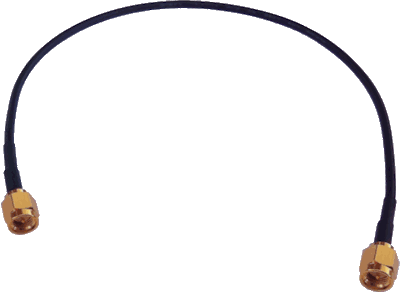
This example is a SMA male type patch cable required for Smart Antenna and many Netcomm and other router/modems.
The patch cables are supplied with two SMA male connectors and an FME male adaptor.Most of our antennas come with an SMA male connector. This allows direct connection to our antenna coax cables or router. 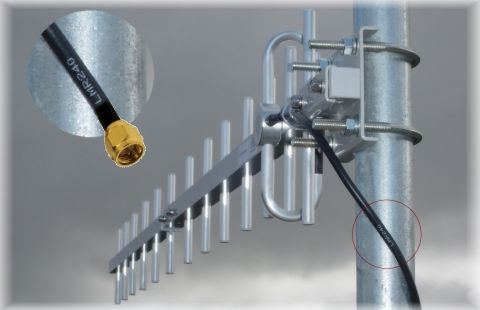
Magnetic Base and Vehicle antennas normally have FME female connectors since they are intended for mobile installations were no additional coax is required. 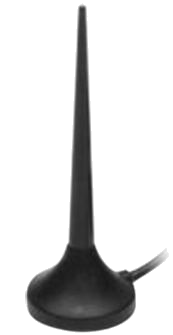
To fit our antennas to OEM coax cables that have N-Type connectors, you'll need to use an Adaptor.
To use N-type coax with our antennas
To use our coax with N-type antennas
Our antenna cables (LMR400 shown) come with SMA female connectors each end. This allows direct connection to our antennas and to a wallplate insert cables or router. 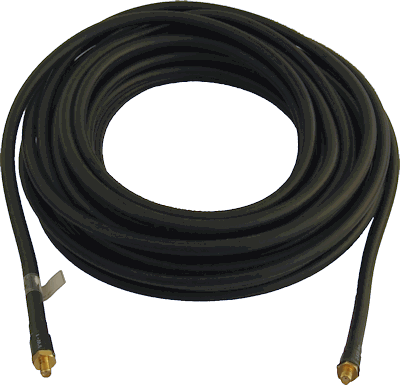
Where the kits are ordered with only one coax cable, and FME final termination, a FME female adaptor may be supplied as required. 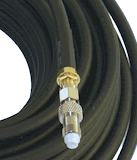
Wallplate inserts are available for SMA cable connectors.
Shown at left is LMR400 fitted to a standard Clipsal Wallplate insert.

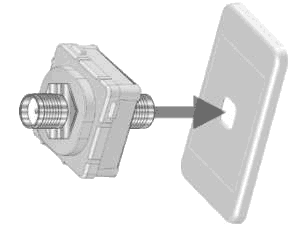
-
-
Do I mount theses antennas Vertically, Horizontal or on a Slant ?
Do I mount theses antennas Vertically, Horizontal or on a Slant ?-
You may have noticed forum discussions and websites showing yagi's mounted horizontally or on an angle to improve reception.
Which way is best?Vertical Polarization (V-Pol)
3G services in Australia and NZ use single-channel, vertically polarized RF antenna systems.
Horizontal Polarization (H-Pol)
This is a standard used in Europe and Asia. Not used in AU or NZ.
Slant Polarization (S-Pol)
Newer 3G services have their antennas "Slant-Pol" for WCDMA, HSPA and DC-HSPA+ Dual-Channel services.
Cross Polarization (X-Pol)
In Australia and New Zealand, 4G and 5G LTE services use an X-pol antenna system.
In USA and some EU countries the MiMo polarisation is H-V.Which Polarisation should you mount my antenna kit?
Single Antenna Systems for 3G or 4G: Vertical
Dual Antenna Systems for 3G : +45deg and -45deg
- Separate antenna connections for each antenna half - Antenna Diversity mode.
Dual Antenna Systems for 4G & 5G : +45deg and -45deg
- Two antenna connections for each antenna section - MiMo mode.
-
-
Which antenna do I need ?
Which antenna do I need ?-
YAGI Antennas
Yagi-uda antennas use parricidic director and reflector elements to achieve the high gain, thus are by design, narrow band. Thus you will see that our 16dBi Yagi antenna covers only 850MHz and 900MHz. The manufacture rates the gain as 16dBi on 900MHz but the practical performance on 850MHz will be lower.
LPDA antennas
Often referred to as a "Yagi" by the layperson due to their similar appearance, Log Periodic antennas are actually a Driven Array, by design have a lower peak gain but can perform better than Yagi antennas due to their very flat Gain vs Frequency characteristic. These can cover a number of bands. Our LPDA antennas are Dual-band, covering 698-960/1480-2700MHz with slightly reduced response up to 3.6GHz also By nature being Wide-Band but Low -mid Gain.
Panel Antennas
There are many different types of Panel type antennas for 4G. Some are high gain designed for one or 2 bands, others may be lower gain covering all 4G bands.
Omnidirectional Antennas
Omni antennas have equal gain in all directions on the horizontal plain. As a result they are limited to a useful gain of about 9dBi. Higher gains are possible however the beamwidth becomes too narrow for most practical applications.
Which antenna should you get?
Poor-Fair: Rural, Marginal, Low signal outside the building:
If you are struggling to get enough signal for 3G/4G, you will need the highest gain antenna with the Low-Loss LMR400 Coax Cable option. Locations with poor outdoor mobile signal usually only have access to the lower frequency bands as these travel further and are less attenuated by rough topology. High-gain antennas designed for 700MHz (B28), 850MHz (B5) and 900MHz (B8) such as our 15dBi 4G 4GX 3G 700/850/900MHz Parabolic Grid Antenna will be needed.More information on our Australian 4G Bands FAQ page.
Fair-Good Signal Areas:
If you get 2-3 bars of outside or up on the roof of the building, you can go for a lower gain, wider band antenna such as the Dual MiMo 14dBi 4GX 4G All Band Antenna kit will also connect to the upper 4G bands is available.Good-Excellent Signal Areas:
If the OUTDOOR mobile broadband signal showing on the modem is about 3-4 bars without an antenna connected, the 11dBi All Band LPDA Antenna would normally be sufficient.
Coax Cable
Poor-Fair signal locations: Always use LL400 (LMR400) coax cable.
Fair-Good signal locations: LL400 (LMR400) coax cable is recommended for cable runs greater than 5m.
Good-Excellent signal locations: LL400 coax cable is recommended for cable runs greater than 10m and when installing lower gain Omnidirectional antennas.5G MIMO antennas
Australian Telcos are updating selected 4G services to 5G specification. A 5G capable device is needed to connect to 5G. Our LPDA antennas also cover the extended 850MHz, the new 1500MHz and, at slightly reduced gain the 3.6GHz bands.
consists of, but not limited to the following:- Upgrade to 4G equipment to use 4x4 (and higher) MiMo rather than the existing 2x2 MiMo.
- Implement a new, faster type of encoding called OFDM.
- More seamless integration with existing WiFi networks.
- Re-farming of existing 3G bands to 5G.
- Adding new bands specifically for 5G, *1500MHz, ~3600MHz and a *26GHz band are proposed.
- Extension of the unused band gap between B28 and B5 (803-824) to extend the 850MHz band.
- Extension of Carrier Aggregation (CA)
* proposed at time of publication
~ ratified at time of publication
Which direction to point the antenna...
To locate cell towers near you, feel free to follow our Online Guide.
-
-
Can I mount the 4G antenna on my TV antenna pole ?
Can I mount the 4G antenna on my TV antenna pole ?-
The 4G antenna can be mounted on the same mast as your TV antenna, however there is one consideration. The 700MHz 4G band uses frequencies that were once used for the UHF TV channels 51-69. If you have an older TV, or TV Masthead Amp (and Older TV antenna) that covers ch51 and above, the 700MHz transmission from your modem may interfere with the TV. In this case it is simply a matter of installing a newer masthead amp or a "LTE filter" on the TV antenna coax line. Newer TVs , Masthead amps and TV antennas that cover only up to ch50 should not have this problem. Ideally, a separation of 400mm or more between the new antenna and the existing TV or Mobile antennas best. If this spacing is not practical, it will most likely ok to mount closer. If problems of interference or less than expected performance arise then it may be necessary to mount the antennas further apart on separate or longer masts.
-
-
Campervan and Caravan Mobile Antennas
Campervan and Caravan Mobile Antennas-
Caravan and Camper Mobile Phone and Broadband Antennas.
Picking the best Mobile Phone/Broadband antenna for use on a Camper or Caravan is a very subjective task.
It usually comes down to a compromise between convenience and performance. Consider whether download Speed or Connectivity is most importance , maybe both are, so you may meed separate systems for best data speed in good signal areas and a booster for poor signal areas.
Rural services run on the lower frequency bands of 700, 850 & 900MHz. These lower bands travel further than the higher 3G/4G/5G bands.
In marginal areas, the highest gain mobile antenna is needed to connect to these services:
Optus/Telstra 4G 700MHz (B28), Vodafone 3G/4G 850MHz (B5), Vodafone/Optus 3G 900MHz (B8). Unfortunately the highest gain antennas such as Yagi, Parabolic Grid or LPDA types are really only suitable for fixed installations and being directional, need to be aimed at the mobile phone tower to work.
Some times you may be camped at a location for only a day or two, other times you may have set up base for weeks or even months.
The type of antenna you install can depend upon your willingness to disassemble/erect an antenna each time you relocate.Finding a compromise between convenience and a system that provides the best connectivity can be difficult.
Poor Signal Areas:
If you need the best connectivity whilst camped at locations with poor 3G/4G signal a booster will be needed. The Nextivity Cel-Fi Go repeater/booster provides up to 70dBi of boost to an the signal from an (omnidirectional) antenna mounted either on the van or towing vehicle. A second "distribution" or "coverage" antenna provides the 4G Hotspot with a coverage area of up to 900sqm. or even better connectivity in very poor signal areas and if you are prepared to put in more effort when camped, erect a pole with a high gain antenna such as a Yagi designed for 4G 700MHz and 3G 850MHz, or an LPDA antenna such as the 14dBi 4GX 4G 3G All Band LPDA Antenna
The Cel-fi GO is a SiSo device that will operate on only one 4G or 3G band at a time. They are also carrier-specific. The data speeds available are slower than that achievable with modern modems especially when connected to an outdoor MiMo antenna system. The Cel-fi GO solution helps keep you connected to the mobile network more often which is important for SMS and phone calls especially in emergency situations. Note that if there is no signal available then no antenna or booster will help.Medium-Good Signal Areas:
The Cel-Fi solution above helps fix problems in poor signal areas. If you want the best data speed available when camped at locations with reasonable signal, a MiMo antenna system, installed atop the van will bring cleaner/quality 4G signal available outdoors (above roof height) to a connected modem/router inside the van.Directional Antenna: better signal - less convenient.
If you always park your van at known caravan parks and/or if you are happy to aim the antenna at the mobile phone tower, a directional antenna will provide the strongest signal to your modem. 4G can operate in SiSo mode with a single antenna but a MiMo antenna will allow the modem to work in the faster MiMo mode. Also, the upper bands may be available, allowing modern modems to connect to multiple 4G/5G bands (CA -Carrier Aggregation) for even faster speeds. Antennas similar to those used for fixed-building installs are suitable if you are prepared to dismantle it before going mobile again. Suitable antennas Dual MiMo 14dBi 4GX 4G All Band Antenna if you get 1-3 bars outdoors, or the Dual 11dBi All Band 4G MIMO Antenna if 3-4 bars are available outdoors.Omnidirectional Antenna: improved signal - more convenient.
For more convenience, a pair of the 8.5dBi 4G/3G Detachable Omnidirectional Antenna mounted each side of the van will be suitable if good outdoor signal is available. Theses have a detatchable spring base for quick removal prior to moving camp. Two antennas are required for MiMo, but as already stated, 4G an operate in the slower SiSi mode using just one antenna.WiFi Calling:
Note that if you get good data speeds using a MiMo antenna system connected directly to your modem, try out WiFi calling via the WiFi hotspot of your modem/router. If never camped in very poor signal areas, you may not need the Cel-fi Go .Conclusion:
It all comes down to what your connectivity and data speeds requirements and how much money you wish to spend.
- If you absolutely need phone connection wherever possible, the Cel-Fi GO booster is needed.
- For the fastest data speeds, a MiMo antenna system connected directly to your modem will be also needed.
-
-
Final affective signal gain estimator
Final affective signal gain estimator-
The type and length of coax cable fitted to an antenna system will determine the amount of signal lost in the process of coupling the antenna to your modem or phone. Use the estimator below to calculate the expected signal strength your modem will see.
-
-
About Coax Cables
About Coax Cables-
LMR series Antenna Coax - 50Ω Low Loss - Double Shielded
Suited to Mobile, Vehicle and Fixed-Wireless installations such as Cars, Trucks, Motor-homes, Office buildings and Homes.
When ordered with our antenna kits, we ensure that the whole thing fits together and will include gender-bender where required.
Double shielded by one layer of Aluminium foil and one close-knit copper braid make for a low-loss coax. Its low signal attenuation figures make it well suited for use at Cell Phone frequencies. Other equivalent prefixes include CLF, KMR.RG58 LMR195 LMR240 LMR400 Impedance: 50Ω Outer Diameter: 4.95mm 4.95mm 6.2mm 10.3mm Inner Conductor: 0.81mm
Copper0.94mm
Solid copper1.42mm
Copper over aluminium2.74mm
Copper over aluminiumOuter Shield: 70% Braid Bonded Aluminium Foil + 95% Tinned Copper Braid Dielectric: Solid PE Physical Foam Polyethylene Pros: cheap Low loss
FlexibleVery low loss Super low loss Cons: High loss more rigid Application: Mobile and Vehicle installations of less than 1m Mobile, Vehicle and Fixed wireless installations of 5-10m in moderate signal areas. Fixed wireless installations <10m in moderate,
<5m in low signal areas.Fixed wireless installations <20m in moderate,
<10m in low signal areas.Signal Loss over 10m cable length (dB) RG58 LMR195 LMR240 LMR400 850 MHz 5.7 3.5 2.4 1.25 900 MHz 5.8 3.65 2.48 1.28 1800 MHz no rated
for use
above 1000MHz5.24 3.6 1.93 2100 MHz 5.5 3.8 2.0 2400 (WiFi) 6.1 4.1 2.2 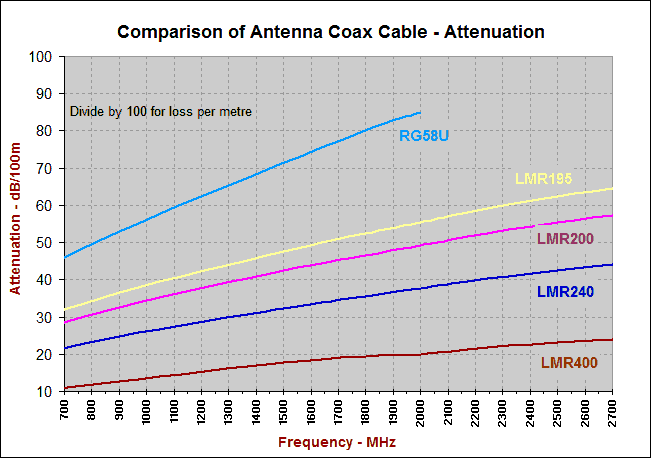
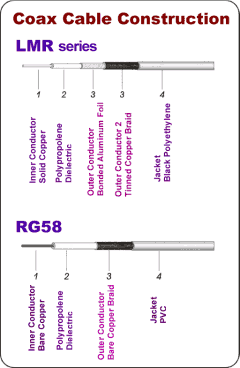
LMR series
The LMR series coax cables are made with low loss Dielectrics (2) and Double shielded with Aluminium Foil (3) and 95% Tinned Copper Braid (3). The outer plastic cover can vary from soft plastic to hard uv rated PVC.
This makes for a very low loss cable suitable for long runs at the microwave frequencies used for 3G and 4G mobile phone services. All our antenna kits are supplied with LMR195, LMR240 or LM400 equivalent as required. Many of our Patch Leads use LMR100A rather than the more lossy RG174 commonly available.RG58
In general, RG series coax such as the common 50 ohm RG85U uses a more lossy Dielectric (2) and only 70% single layer outer shield (3). These cables are not rated for use above 1GHz and are not suitable for use with cell phone antenna systems at cable lengths over about 1-2m. RG174 is used for most Patch Leads for its flexibility. RG174 is more lossy than the LMR100 coax we fit to our Patch Leads. This can make a difference at higher cell phone frequencies.
TV type RG6 and RG11 (75ohm) coax
TV and Satellite antenna systems use 75ohm (RG6 RG11) coax cables. Whilst these are high quality coax cables they are unfortunately not recommended for use with mobile phone and wireless broadband antenna systems for the reasons:
- The N, SMA and FME type connectors used for MBB antennas are not compatible with the RG6/11 coax.
- RG6/11 coax is 75ohm which will cause a high SWR when attached to 50ohm 3G/4G/5G MBB devices.
- This impedance mismatch may cause damage to modems due to the high level of reflected power at the 50ohm/75ohm junctions.
- Poor performance may result, depending on the real-world antenna impedance may result.
** We do not guarantee the performance for of nor provide warranty for our antenna systems when used with the incorrect coax cable.
If you wish to try our antennas with TV type RG6/11 type coax cable, we have F-type adapters available.
-
-
Directional vs Omni-directional-antennas
Directional vs Omni-directional-antennas-
Fixed Wireless Installations
Directional - Yagi, Panel and LPDA antennas
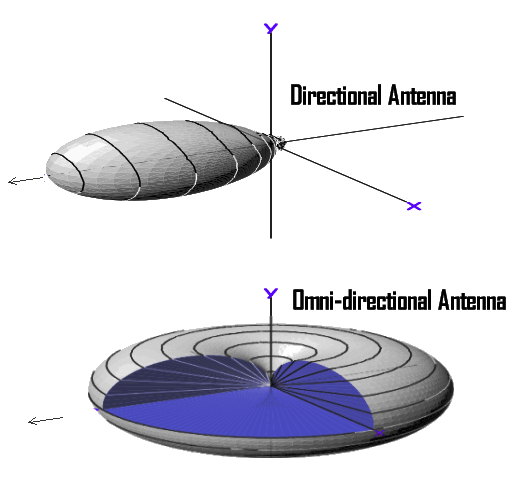 Omnidirectional antennas achieve higher gain by flattening out the "doughnut".
Omnidirectional antennas achieve higher gain by flattening out the "doughnut".Advantages
- Higher gain, providing more "bars" of signal.
- Less interference from the side and from behind the antenna.
- Better Signal-to-Noise Ratio providing better Signal Quality for the
same Signal Strength of omnidirectional antennas.
- Possible to connect to more distant, lower signal cell towers that
may have less traffic load than your closest tower.Disadvantages
- Must be aimed at the cell tower.
- Not suitable for Mobile Installations.Recommended Directional Antenna Gain
Marginal Signal Areas: High gain Low-band antenna Good Signal Areas: 11-14dBi All-band antenna Mobile Installations
Mobile Homes, Caravans and Motor Vehicles
Omni-directional - (Broomstick and Whip) antennas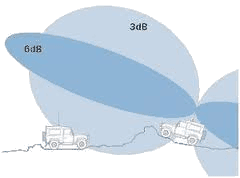 If you're constantly on the move you need an antenna that can connect to cell towers in any direction.
If you're constantly on the move you need an antenna that can connect to cell towers in any direction.
Vehicle speed, terrain changes and boat angle/movement effect the angle of the antenna, causing reliability issues with higher gain antennas.Advantages
- No need to aim at the cell tower.
- Ideal for Mobile Installations.Disadvantages
- Lower gain, providing less signal.
- Wanted and unwanted signals collected equally from all directions.Recommended Omnidirectional Antenna Gain
Mobile Homes and Caravans: 7-9dBi All-Band Road Vehicle, Metro Areas: 3-7.5dBi All-Band Road Vehicle, Country Areas: 7-9dBi All-Band Off Road Vehicle, 4WD: 3-7dBi All-Band Marine, Boats, Yachts: 3-5dBi Single/Dual Band
There are several scenarios for Motor-Homes, Caravans and Campers.
A. When you are located for long periods (months) in the same location, moving camp only occasionally:
Directional antenna will be best as this can be treated as a Fixed Wireless installation.
B. When you are shifting location only about a week or so.
These situations call for something that is high gain to give you the best signal in remote locations, and omnidirectional, giving the flexibility to just plug your phone/modem in and get connected. Unfortunately, no such antenna exists. To achieve say 16dBi gain, you need a directional antenna, and an omnidirectional antenna is limited to 7 or 9dBi.
Here we recommend installing both a permanently mounted 7.5 dBi Fibreglass whip and also have available a 16dBi Yagi and pole for situations where the Omni just does not quite give you enough signal when in remote areas.
https://onwireless.com.au/16dbi-850mhz-3g-yagi-antenna-for-hspa-wireless-broadband-fme.html
C. When your constantly travelling, only staying at a a location for one or two nights.
Unless you are preferred to setup a pole and mount the Yagi / LPDA directional antenna every night, you need and the convenience to just plug your phone/modem in and get connected.
Here the best option is a permanently mounted Omnidirectional antenna like our 7.5 dBi Fibreglass whip.:
https://onwireless.com.au/7dbi-850-900-nextg-3g-gsm-3dbi-1800-2100-4g-lte-spring-base-fibreglass-vehicle-antenna-fme.htmlMarine Installations
Boats and Yachts
Omni-directional - "Broomstick" Antennas with Stainless Bases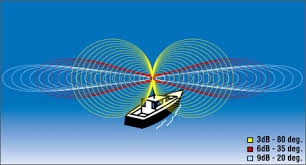
The difficulty with marine installations is that the best antenna for calm water is different to that for rough seas.
Two antenna-systems will allow your modem to connect to 4G towers in MIMO mode and assist with 3G connection stability towers in Antenna Diversity mode
A 850/900MHz 3G signal will travel further out to sea than 4G LTE 1800MHz. The affect of the curvature of the earth takes effect at about 30km depending on the height of the cell tower antennas. The higher your antenna is, the farther the signal can reach. The angle of the antenna and azimuth of the boat is constantly changing and can be quite acute in rough seas. The lower gain , top-loaded 3dBi marine whips are best.
And with two antennas to suit 4G and 3G modems with the two antenna ports your modem will help stay connected in rough waters. If you only want to support in calmer waters then the higher gain marine/vehicle antenna will do well.Recommended Marine Antenna for various devices
Mobile Phone: 3-6dBi Omnidirectional. MBB Modems: 1x 3dBi 1.8m Omnidirectional - Port 1
1x 6-7.5dBi Omnidirectional - Port 2
-
-
How does signal strength translate to download an upload speeds ?
How does signal strength translate to download an upload speeds ?-
Signal Strength vs Signal Quality
- Signal Strength: How many "bars" or "dBm" are showing on your device.
- Signal Quality: how "clean" the signal is.
Improving signal strength to your device is normally the best way to get a better connection to your 3G or 4G service.
Generally speaking, Improved Signal Strength = Increased Data Transfer Speed.
In reality, things are a little more complicated. Installing an antenna system can definitely solve the signal quality problem, after that its up to a whole bunch of other factors, mostly on the Telco side....Think of these antenna kits as being a device that removes one of the "weak links in the chain".
Installing a high-gain directional antenna improves the signal strength and the signal quality by collecting more of the intended signal from the tower and less interference from neighbouring cell towers, other transmitters and background RF interference.Connection Quality
- Speed of data transfer: is it fast, smooth and consistent?
- Stability: does the modem stay connected, without dropping out or downloads stalling?
Although there tends to be relationship between signal strength and signal quality, signal quality and connection quality are more closely related.
With good Signal Quality:- Modem will spend less time performing error checking and error correction tasks.
- Modem will not repeat downloads of data packets when it cannot correct errors.
- Thus the modem will have more time available to download/upload data.
- During Peak-Load times your Modem/Phone will be allowed to stay connected to the cell tower while customers with lower quality connections will be dropped or speed limited. The cell tower decides this automatically based on a complex algorithm mostly influenced by the quality of the connection.
- The transmit power of your modem will be lower, using less power and running cooler.
RE: Other Factors affecting Connection Speed
There are other factors that we have little control over.
These are to do with the quality of the service provided by your Mobile Broadband/Mobile Phone company, including but not limited to:
- Backhaul: How fast can the data get to/from the Cell Tower by the Telco's own microwave, fibre links..
- How many licenses (data pathways) does the Cell Tower have installed.
- How many customers (aka subscribers) are tying to use the service especially at peak periods.
- Optus and Telstra re-sellers may not be allocated a teir-1 priority service. Thus customers of re-sellers may not get the same speed and connection quality as a customer of the originating Telco.
- The type of Plan you have. Some SIM plans are speed limited.
- The specifications and quality of the modem/phone you have.
- Your location to the tower and how many other connection sources are available for your modem to connect to.
- Using a 4G MIMO antenna with a 4G MIMO modem (2 antenna ports) allows your modem to operate in MIMO mode if the Cell tower is MIMO enabled.
Not all towers are 4G MIMO capable, thus using a MIMO antenna does not always guaranty higher speeds. You will get higher DL speeds only if the Cell Tower is capable of doing so.Conclusion
Q: So.. how does signal strength translate to download an upload speeds?
A: As a general rule, notwithstanding the other factors involved:
Improved Signal Strength => Improved Signal Quality => Improves Connection Quality => Increased Data Transfer SpeedExceptions to the Rule
Q1: What situations would show no or only little improvement after installing an antenna.?
A: Not many, but there are odd occasions where things don't work out. Notwithstanding the telco side issues listed above.- When the signal path from your location to the tower is over water, the signal reflected off the waters surface can interfere with the direct signal causing fluctuating signal strength and/or unstable connection.
- When there just isn't have enough signal no matter what antenna you use.
- Where there is not a strong signal from the direction of the tower, rather the modem is seeing a combination of reflected, refracted, diffracted and direct signal from one or a number of cell towers, possibly ever-changing.
- Where your signal quality is already good, improving the signal strength may make no difference to download speed.
Q2: I have good signal strength but my modem still drops out and the data transfer speed is too slow, what gives?
A: Normally this problem is due to Poor Signal Quality for the reasons outlined above. Our customers report this issue constantly and most often in the following situation:- Modem is being used inside a building without an external antenna.
- The modem may be constantly dis-connecting and reconnecting to different towers or even different services and/or bands on the same tower, not ever connecting to any service properly.
- The strong signal may contains a lot of interfere. Thus the Signal Quality is poor
Here the aim of installing a high-gain directional antenna is to fix the signal quality issue rather than signal strength.
-
-
What is the maximum range of these antennas ?
What is the maximum range of these antennas ?-
Factors that Determine Antenna Range.
With MBB antenna systems, there are many factors that determine the distance that your location can be from the tower to be able to get enough signal to achieve a good connection:
Line of Sight (LOS)- Obstructed path from Your Antenna Position to the antennas on the Cell Tower.
These include hills, mountains, forest, scrub, buildings etc. This is called Line-of-sight . - Any obstructions will cause signal degradation and the higher frequencies are most effected.
- The lower frequency 3G bands of 850 and 900 can refract (bend) around obstacles to some extent, often enough to get quality signal to your location.
- The higher frequency 3G bands of 2100 and 4G 1800 generally require direct line-of-sight.
Exceptions to this are if you are very close to the cell tower or the signal is reflected of an obstacle. - The bigger the obstacles, and more obstacles there are in the path, the less signal you are likely to see at your location.
- Bodies of water also cause problems that may reduce the signal strength.
- Atmospheric conditions such as "solar radiation" when the sun is in the direct path of the antenna alignment to the tower.
This electromagnetic "noise" can cause connection drop-outs. - The curvature of the earth creates an obstacle to the signal path over distances greater than about 26-30km. Most effect when over, and least influence when the cell tower and your location are at high altitude with a valley in-between.
In practice the maximum distance could be around 75km for 3G 850MHz and about 40km for 4G 1800MHz.
Cell Tower Maximum Range.
The Mobile Phone Cell Towers themselves have a maximum range built into the software configured by the service provider. This is the maximum time it takes for the handset to respond to a request from the cell tower, beyond which the tower will reject a connection. The intention of this is to restrict the tower from being oversubscribed.
Rural towers may be set to a "Service Window" of 135km.
Metro towers may be set with a service area as low as 30km.
Handset Power
Whilst the tower power may be 20W or even over 100W, a Modem/Phone will only transmit at a maximum of 0.25W or 23dBm.
An 11dBi antenna, being a lower gain having to cover many bands, will not have the same range as a 16dBi Yagi antenna that targets a single band.
Other factors
Getting a strong signal and solid connection to the cell tower is only half the battle.
We cover this topic here: Signal Quality and Strength FAQ page
Maximum Range FAQ page - Obstructed path from Your Antenna Position to the antennas on the Cell Tower.
-
-
Troubleshooting Guide
Troubleshooting Guide-
Troubleshooting
The most common problems experienced by our customers are that either the antenna has been pointed in the wrong direction, is the wrong antenna for the task or there is just no service available.
1. Check that the antenna you have is designed for use on the same band that your modem is using to connect.
This will be less of an issue with multi-band antennas, but for the very high gain Yagi Antennas you may find that the tower is using a band not supported by the antenna. Check your antenna specs against the charts shown here:
Australian 3G frequencies
Australian 4G frequencies
2. Double check your order to ensure you have ordered and been supplied with the correct Patch Lead for your Modem or Phone.
If in doubt, please contact us including a clear photo if needed.
3. The first step is to ensure that you have the correct antenna for your service and that you are pointing it in the right direction.
If not already done so, please familiarize yourself with the towers and their frequencies.
Instructions can be found at locate.onwireless.net .
More info can be found at faq.onwireless.net .
Tower info can be found at towers.onwireless.net
4. If, having ensured that the antenna is correctly installed, you find that the antenna system is still not performing, please follow our guides below:
Antenna stopped working
Can't get my new antenna to work
5. If still no luck, please fill out our assistance page by clicking the link below.
This form provides us with much of the info that we need to assist you to solve you antenna system trouble.
I'm having trouble getting my antenna to perform.
Troubleshooting your Antenna Installation FAQ page
-
About 3G, 4G and 5G
-
What is 3G ?
What is 3G ?-
3G Mobile Phone Service
The 3rd generation of mobile telecommunications technology.
3G uses the UMTS or "Universal Mobile Telecommunications System" mobile cellular system for networks based on the GSM standard. Developed and maintained by the 3GPP (3rd Generation Partnership Project), UMTS is a component of the International Telecommunications Union IMT-2000 standard. UMTS uses wideband code division multiple access (WCDMA) radio access technology to offer greater spectral efficiency and bandwidth to mobile network operators.
In Australia the term "3G" is used to market any service using UMTS, HSPA, HSPA+ or Dual Carrier HSPA+.
Optus 3G is simply any of their UMTS services on 900MHz and 2100MHz.
Vodafone 3G is anything from UMTS to HSPA on 850,900 and 2100MHz. Their new 3G+ service being DC-HSPA+ on the 850MHz Band.
Telstra Next-G is their branding of 3G and 3G Advanced using the UMTS, HSPA, HSPA+ and/or
Dual Carrier HSPA+6 on the 850 and 2100MHz bands.Advantages (over GSM)
Efficiency
Low RFI-
-Handsets transmit at lower power to achieve the same connectivity.
A 3G phone needs to output only 1/8 of the power to perform the same function as a GSM phone.Security - The 128bit encryption algorithm used for 3G is much more difficult to crack than the algorithm used for GSM. Thus phone tapping is no longer a problem (unless you are a jounalist with Murdock newspapers) Faster - HSPA (HSDPA/HSUPA) protocol provides for download speeds of up to 14Mbps and now
42Mbps with the new DC-HSPA+ services.Disadvantages
Range - Although superior in range to GSM, the earlier 3G services, and those in metro areas used the 2100MHz band which is considered a short-range band due to its high frequency.
This is largely overcome by the use of additional 3G services on the 900MHz band by Optus and Vodafone
and the 850MHz band by Telstra and Vodafone.Refer to the "What Frequency does 3G and 4G use in Australia" section for more band definitions More information is available on the whirlpool forum
-
-
What is NextG ?
What is NextG ?-
Next G is a 3G network operated by Telstra in Australia on 850 and 2100MHz.
 Next-G, really a "3.5G" network, was launched in October 2006. By December 2008 the Next G Network was the fastest mobile network in the World, delivering theoretical network speeds of up to 21Mbit/s utilizing features of HSPA+ and Dual-Carrier HSPA. In February 2010 Telstra increased the speed of some services to 42Mbit/s using Dual Carrier HSPA+ technology.
Next-G, really a "3.5G" network, was launched in October 2006. By December 2008 the Next G Network was the fastest mobile network in the World, delivering theoretical network speeds of up to 21Mbit/s utilizing features of HSPA+ and Dual-Carrier HSPA. In February 2010 Telstra increased the speed of some services to 42Mbit/s using Dual Carrier HSPA+ technology.
Next-G is currently used for BigPond's wireless broadband service and Telstra Mobile, which is Australia's largest mobile telephone service provider.
In September 2011 Telstra launched its 4G 1800 Mhz LTE network, claiming typical download speeds of up to 40Mb/s.
Telstra Next G is their branding of 3G using the UMTS, HSPA, HSPA+ or DC HSPA+
-
-
What is HSPA+ and DC-HSPA+ ?
What is HSPA+ and DC-HSPA+ ?-
HSPA+ (Evolved High-Speed Packet Access)
HSPA+ is an enhanced version of high-speed WCDMA (UMTS) based 3G wireless networks. Being built on 3G, HSPA+ is often referred to as 3.5G. In June 2008 the Telstra Next G network was the first to enable some features of HSPA+.
In Australia, HSPA+ provides theoretical maximum downlink data rates3 up to 21Mbit/s and uplink data rates up to 5.8Mbit/s when connecting with 21Mbps HSPA+ capable devices. Actual data rates will be much lower, being dependent upon the number of customers connected to a particular tower, the back-haul7 data rate, and the quality of the connection to the mobile phone tower.DC HSPA+ (Dual Carrier or Dual Cell HSPA+)
In Australia, DC HSPA+ is able to achieve downlink data rates3 up to 42Mbit/s and uplink data rates up to 14.4Mbit/s when connecting with 42Mbps DC-HSPA+ capable devices, Through the use of a multiple-antenna technique known as MIMO (multiple-input and multiple-output) and higher order 64QAM modulation, combining multiple cells into one.
A typical DC-HSPA+ Telstra tower will have two sets of Receive and two sets of Transmit antennas. Each of these sets has slant-polarized antennas at ±45º rather than the vertically polarized antennas used with the original 3G standard. In addition, to cover an area 360º around the tower, there may be 3 sectors, each spaced 120º apart, each with their own Cell-ID, providing their own data service. Note that the antennas may only be aimed in one particular direction, and there may only be one or two sectors, in situations where the carriers has seen fit to not provide service in all directions.Browse to web.acma.gov.au/pls..ID=500961 for an example of a DC-HSPA+ capable tower:
Carrier A: 3 pairs of sectors: 839.8MHz for Receive and on 884.8MHz for Transmit polarized at +45º,
Carrier B: 3 pairs of sectors: 840.0MHz for Receive and on 885.0MHz for Transmit polarized at -45º.Note also the Emissions Designator for Telstra nextG services on 850MHz always ends with *7WEC.
Also on this tower is an Optus 3G 900MHz service identified by the Em Des ending with *G7W.The net isolation between antennas is 90º so that each carrier can operate independently.
Likewise, to connect at full speed to a DC-HSPA+ wireless internet service, your modem will need to have two separate physical antenna ports connected to Dual Antenna systems commonly called "slant-pol" or "MIMO" antennas.
Our 16dBi Yagi Kits are perfectly suited for the DC HSPA+ service provided by Telstra next G and Vodafone 3G+.Highlighted in the extract from the ACMA radcom website below are one recieve (Rx) channel of a DC HSPA+ service. The other Rx Channel is shown underneath it at 840.0MHz. These two channels have antennas that are slant-polarized at 90°apart. The corresponding transmit (Tx) channels are shown at 884.8MHz and 885MHz.

-
-
What is 4G and LTE ?
What is 4G and LTE ?-
4G (LTE) Services in Australia
4G is the fourth generation of the mobile phone communications standard, a successor of the third generation (3G) standards. "LTE" stands for Long Term Evolution and 4G LTE is an advanced 4G service built on 3GPP Long Term Evolution technology.
Telstra 4G LTE
Telstra were the first to introduce 4G LTE in Australia in 2011 and have their 4G LTE services in major centers around Australia. Telstra 4G services use the 700MHz (B28), 900MHz (B8), 1800MHz (B3), 2100MHz (B1) and 2600MHz (B7) bands
Optus 4G LTE
Optus 4G services use the 700MHz (B28), 1800MHz (B3), and 2600MHz (B7) bands.
Optus also has TD 2300MHz (B40) licenses it acquired when it took over VividWireless.Vodaphone 4G LTE
Vodafone installed their new 3G+ service and a 4G LTE service simultaneously. Some cell towers may have both 3G, 3G+ and 4G services on the same band. 4G services use the 850MHz (B5) and 1800MHz (B3). With the merger of Vodafone with TPG it is expected that Vodafone will implement 4G/5G on the 2600MHz (B7) licenses currently unutilised by TPG.
For full speed 4G LTE, you'll need a MIMO Antenna system.
-
-
What are the Categories of 4G and 5G ?
What are the Categories of 4G and 5G ?-
4G & 5G Modem Carrier Aggregation Categories of LTE-Advanced
At time of writing there are 20 different LTE UE categories defined. The table below lists the most common. To be updated... Under Construction Category * Max Bandwidth / CA
component carriersMax. MIMO
layers64QAM Support Maximum Theoretical DL/UL Speed Cat 4 20MHz 2CC
2 x 10MHz download
1 x 10MHz upload4 No 150/50 Mbps Cat 6 40MHz 2CC or 3CC
20+20 or 20+10+10 download2 or 4 No 300/75 Mbps Cat 9 60MHz 3CC
3 x 20MHz download
1 x 20MHz upload2 or 4 No 450/50 Mbps Cat 11 3 x 20MHz download
1 x 20MHz upload2 or 4 600/50 Mbps Cat 12 3 x 20MHz download
2 x 20MHz upload2 or 4 600/100 Mbps Cat 16 *** 2 or 4 1000/na Mbps Cat 20 *** ludicrous ;-) The speeds listed are maximum theoretical. The practical speeds will be lower, subject to many other factors.
Maximum data rates shown are for 20 MHz of channel bandwidth. Categories 6 and above include data rates from combining multiple 20 MHz channels using Carrier Aggregation. Maximum data rates will vary between Service Providers as different bandwidth is utilised.* The number bands that a modem can connect to, which bands and whether TDD+FDD is supported is only loosely proportional to its category specification. Consult the manual for model specific capability. The above list is a guide only. Carrier Aggregation explained LTE Advanced Categories FAQ page
-
-
What are the Australian 3G frequencies ?
What are the Australian 3G frequencies ?-
Australian 3G Wireless Broadband & Mobile Phone Frequencies
The information provided is current at time of writing and subject to change without notice. Carrier/Service Band Mode Bandwidth 4 Antenna Type #Telstra 850MHz
Band 53G UMTS/HSPA DL: 875-890 MHz
UL: 830-845 MHz
Vertical Pol
Omnidirectional#Telstra
DC-HSPA+ Dual Carrier
Slant Pol%Vodafone 3G UMTS/HSPA Slant Pol %Vodafone 3G+ DC-HSPA+ Dual Carrier
Slant PolOptus (900) 3G 900MHz
Band 8
UMTS/HSPA DL: 943-952 MHz
UL: 898-907 MHzVertical, Slant Pol
or
Omnidirectional
Vodafone (900) 3G UMTS/HSPA DL: 951-960 MHz
UL: 906-915 MHz!Vodafone, Optus, !Telstra
3G - voice/sms/data2100MHz
Band 1UMTS/HSPA DL: 2110-2170 MHz
UL: 1920-1980 MHzSlant Pol !Telstra has re-farmed its 2100MHz (B1) services as 4G.
#Telstra plans to have all 3G services shutdown by mid 2024.
%Vodafone is phasing out 3G 850MHz and 2100MHz, re-farming it to 4GAustralian 3G Bands FAQ page
-
-
What are the Australian 4G frequencies ?
What are the Australian 4G frequencies ?-
Australian 4G Wireless Broadband & Mobile Phone Frequencies
The information provided is current at time of writing and subject to change without notice. Carrier/Service Band Mode Bandwidth 4 Antenna Type Optus 700MHz
Band 28
4G FDD
UL 703-713MHz
DL 758-768MHzMIMO
X-PolarizedTelstra UL 713-733MHz
DL 768-788MHzVodafone 850MHz
Band 54G FDD DL: 875-890 MHz
UL: 830-845 MHzMIMO
X-PolTelstra
limited bandwidth, re-farmed from 3G900MHz
Band 84G FDD DL: 943-952 MHz
UL: 898-907 MHzMIMO
X-PolTelstra 1800MHz
Band 34G FDD DL: 1805-1820 MHz
UL: 1710-1725 MHzMIMO
X-PolOptus (and Virgin) DL: 1840-1850 MHz
UL: 1745-1755 MHzVodafone Telstra
limited bandwidth, re-farmed from 3G2100MHz
Band 14G FDD DL: 2110-2170 MHz
UL: 1920-1980 MHz2x2 MiMo X-Pol Optus 2300MHz
Band 404G TDD 2302~2400 MHz
shared between UL/DLMIMO - X-Pol Vivid Wireless (Optus/BKAL) Optus
2600MHz
Band 74G FDD UL 2550-2570MHz
DL 2670-2690MHzMIMO - X-Pol Telstra 4G FDD UL 2510-2550MHz
DL 2630-2670MHzMIMO - X-Pol TPG / Vodafone 4G FDD UL 2500-2510MHz
DL 2620-2630MHz4G LTE 700MHz and 2500MHz Mobile Broadband Spectrum
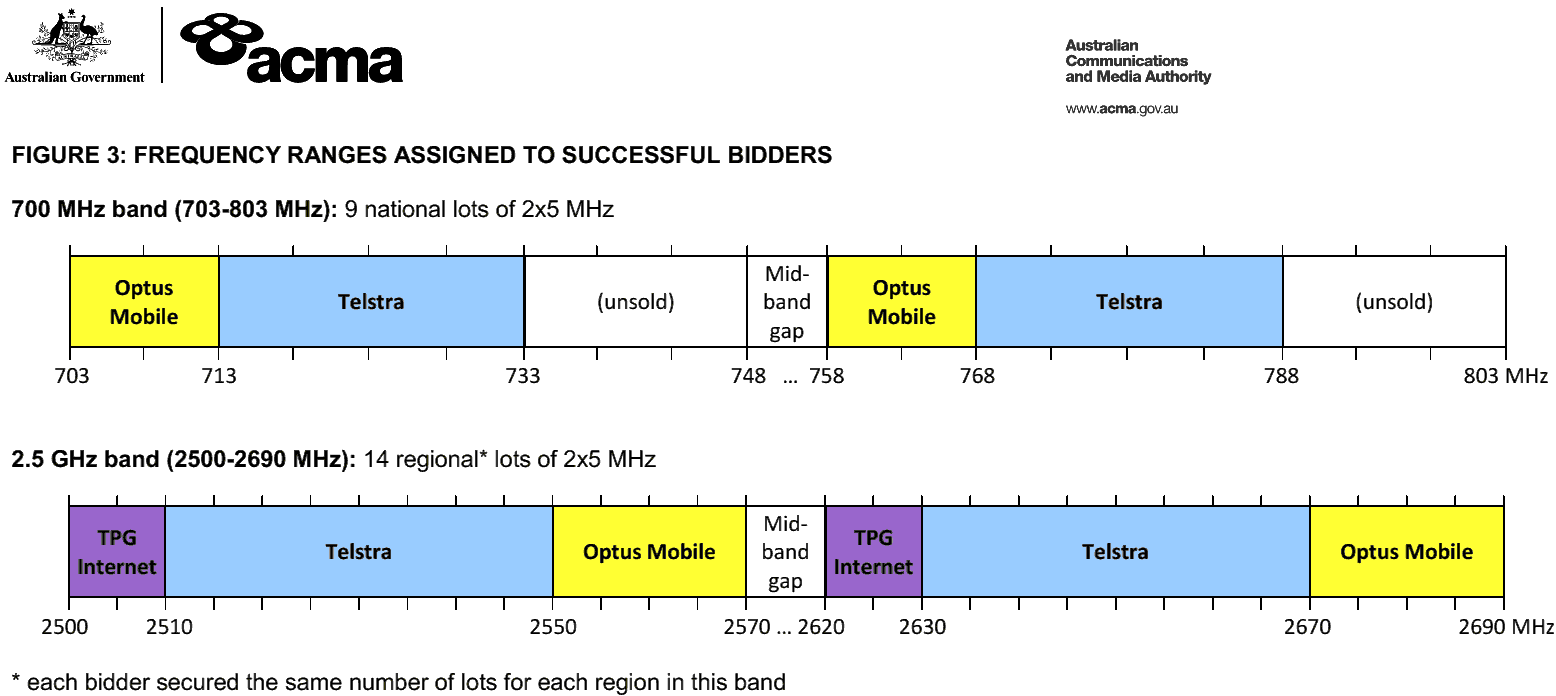
The information provided is current at time of writing and subject to change without notice.
-
-
What are the Australian 5G frequencies ?
What are the Australian 5G frequencies ?-
Australian 5G Wireless Broadband & Mobile Phone Frequencies
The information provided is current at time of writing and subject to change without notice. Note that "5G" also incorporates 4G bands using Carrier Aggregation to achieve full speeds available, not only utilizing the new 3.6GHz band. For example the Nokia FastMile 5G Gateway from Optus can CA on up to 4 bands as follows:
– 1x 4G LTE + 1x 5G (B1+n78, B3+n78, B7+n78, B28+n78)
– 2x 4G LTE + 1x 5G (B1+B3+n78, B1+B7+n78, B3+B7+n78)
– 3x 4G LTE + 1x 5G (B1+B3+B7+n78)Carrier/Service Band Mode Bandwidth 4 1Consideration is being given to concatenate B5 and B8 covering 809-960MHz into one 5G band.
Not formally ratified850MHz extended
Band 5809~890 MHz 900MHz
Band 8890~960 MHz 1Consideration is being given to the 1500MHz 5G band.
Not formally ratified1500MHz
Band n74 TBD1427-1518 MHz Telstra, Vodafone and Optus 3.5GHz Band n78
(3.6GHz 3300 MHz – 3800 MHz)TDD Australia
3575-3700MHzTelstra 26 GHz
n25824.25–27.5 GHz 1 For reference only, not currently in service.
The information provided is current at time of writing and subject to change without notice.
References: https://en.wikipedia.org/wiki/LTE_frequency_bands
https://en.wikipedia.org/wiki/5G_NR_frequency_bands
https://en.wikipedia.org/wiki/List_of_5G_NR_networks
-
-
How Much Signal is a Good Signal?
How Much Signal is a Good Signal?-
4G LTE Network Statistics - Glossary
RSRP
(dBm)RSRQ
(dB)SINR
(dB)Rating Expected Connectivity ↑ -84 ↑ -5 ↑ 12.5 Excellent Fast speeds with no drop-out -85 to -102 -5 to -9 12 to 10 Good Fast speeds with no drop-out -103 to -111 -9 to -12 10 to 7 Fair Normally no problem, longer latency,
fair but useful and reliable data speeds may be attained-112 ↓ -12 ↓ 7 ↓ Poor Dramatically lower data speeds and regular disconnects. May not connect. RSSI: Received Signal Strength Indication.
This is not a significant measurement for 4G although most modem firmware will return a value for 4G.
Measures the average total received power of the carrier. RSSI includes the power from co-channel serving & non-serving cells, adjacent channel interference, thermal noise, etc. Thus RSSI is not a significant parameter for 4GRSRP: Reference Signal Received Power
RSRP is a RSSI type of measurement. In simple terms RSRP measures just the usable portion of the signal thus is a more accurate measure of signal strength than RSSI as it excludes interference and noise on the connected network.
RSRP value will normally be a lower (more negative) value than RSSI by about -20dBm.RSRP is the main parameter used to make ranking among different candidate cells in accordance with their signal strength. Generally, the reference signals on the first antenna port are used to determine RSRP, however, the reference signals sent on the second port can also be used.
RSRQ: Reference Signal Received Quality
RSRQ indicates the quality of the received reference signal. Used as additional information to make a reliable handover or cell re-selection decision when RSRP is not sufficient.
RSRQ = RSRP / RSSI3G Network Statistics - Glossary
RSSI
(dBm)RSCP (dBm) EC/Io
(dB)Rating Expected Connectivity ↑ -51 to -73 ↑ -5 ↑ -2 Excellent Not affected by cell breathing/loading -75 to -83 -5 to -9 -2 to -5 Good Normally no problem.
Should hold a connection, even with heavy cell loading-85 to- 95 -9 to -12 -5 to -10 Fair Workable under good conditions where interference from neighbouring towers is not present. Could suffer poor data speeds and occasional dropped connection. -97 to -113↓ -12 ↓ -10 ↓ Poor Dramatically lower data speeds and regular disconnects. May not connect. RSSI: Received Signal Strength Indication
RSSI is a dBm signal strength indicator of the wideband signal for the full band to which the device is connected. RSSI is more useful for 2G/GSM signal strength measurements.
Measures the average total received power of the carrier. RSSI includes the power from co-channel serving & non-serving cells, adjacent channel interference, thermal noise, etc. Whilst RSSI is an indicator of available signal, RSCP is a more accurate indicator for 3G not a significant parameter for 4GRSCP: Received Signal Code Power
The pilot channel power level received by the mobile handset or modem for the connected cell (code signal). Different cells using the same carrier are compared using this value to make cell re-election and cell handover decisions.EC/Io: Energy per chip (Ec) to total received power (Io) ratio.
This is the ratio between the connected code signal (RSCP) from the cell tower and the total noise, interference from other towers and non code signals (RSSI).Higher (less negative) values can indicate a better signal quality.However EC/Io is often misleading due to the nature of the interfering signals, and varies with the number uf users connected to the cell.
This value is less than 1 and negative when expressed as dBm.
Calculated as follows:
Ec/I0 [dB] = RSCP [dBm] – RSSI [dBm]Cell ID: The ID number of the Cell tower.
For Fixed Wireless installations, this value should not change. If Cell ID changes at particular times of the day, especially at peak hour traffic times, this indicates that the tower you normally connect to may be over loaded/oversubscribed or changing environmental conditions result in the strongest signal is coming from an alternate tower.The above signal values vs Connection Quality tables are intended as a guide only. Different sources suggest slightly different values. Every attempt to present as accurate info as possible has been made and no responsibility is taken by remoteone for errors and/or differences to other references. If you spot an error please let us know. Signal Strength vs Quality FAQ page
RSRP is a more accurate measure of signal strength than RSSI, as it excludes noise and interference on the network. It measures just the usable portion of the signal. Although the 4G RSRP signals appear lower, it does not mean your signal level is worse.
-
Coverage Maps and Cell Tower Locations
-
Coverage Maps
Coverage Maps-
Mobile Phone and Wireless Internet Coverage Maps
Australia
Some info on this page is out of date and currently being updated

Telstra Next-G Coverage Maps
Click here to view: Telstra Mobile Phone and Mobile Broadband Coverage Maps
Maps show current Telstra coverage based on expected speeds rather than service type.
Optus Coverage Maps
Click here to view: Optus Mobile Phone and Mobile Broadband Coverage Maps
Maps show current Optus coverage for single and dual band 3G and the new Optus 4G service.
Virgin Mobile Coverage Maps
Click here to view: Virgin Mobile Phone and Mobile Broadband Coverage Maps
The Virgin Mobile network uses the Optus network.
Vodafone Coverage Maps
Click here to view: Vodafone Mobile Phone and Mobile Broadband Coverage Maps
Kogan Coverage Map (Telstra wholesale reseller)
Click here to view: Kogan Mobile Coverage Maps Kogan plans resell Telstra's wholesale mobile services.
Boost Mobile's Coverage Map (Telstra wholesale reseller)
Click here to view: Boost Mobile Coverage Maps Boost Mobile plans resell Telstra's wholesale mobile services.
NBNCo
The NBN Fixed Wireless service is being rolled out to households outside the proposed fibre optic areas and it is estimated that about 4% of Ozzie premises will have access to this fixed wireless service.
The service uses advanced technology similar to LTE or 4G on 2300MHz, with wireless internet connection speeds up to 12Mbps download & 1Mbps upload. NBN contracts to Skymesh for its Fixed Wireless services. Hardware is supplied by NBNCo. Hardware includes an outdoor roof-mounted antenna/modem with network termination inside the building.
Thus we do not supply antennas for NBN equipment. More Info.
Click here to view the NBN Rollout Map.
New Zealand

Telecom New Zealand Coverage Map
Click here to view: Telecom NZ Mobile Phone and Mobile Broadband Coverage Maps
A visual guide to the the XT network's 3G mobile voice & data coverage areas for 97% of kiwis.
Malaysia

Celcom Mobile Phone Service - Malaysia
Click here to view Celcom Malaysia Coverage Information
At time of writing, no detailed maps were available on the telco's website. Celcom uses the 900MHz but mainly the 1800MHz band for GSM and the 2100MHz band for their dual-channel HSPA+ 3G network. The Celcom 3G network provides speeds of up to 42Mbps.
YES 4G Mobile Phone Service - Malaysia
Click here to view YES Malaysia Coverage Information
YES uses the 2300MHz for their 4G WiMax network.
P1 4G Mobile Phone Service - Malaysia
Click here to view Packet One (P1) Malaysia Coverage Information
P1 uses the 2300MHz for their 4G WiMax and aG TD networks.
P1 also has licences in the 2.6GHz band that may be put into service at some future date.
Philippines

Globe Telecom Mobile Phone Service -Philippines
Globe Telecom website
GSM Frequency Band - 900 MHz/1800 MHz (Dual Band)
3G Frequency Band W-CDMA (UMTS) - 850Mhz/2100 MHz
UMTS/3G 1900(uplink)/2100(downlink) (Dual Band)
Globe 4G Mobile Phone Service -Philippines
Globe Telecom website
HSPA+ WiMAX 1800Mhz
Smart Communications Mobile Phone Service -Philippines
Smart Communications website
Smart LTE coverage
GSM Frequency Band - 850Mhz/900 MHz/1800 MHz (Tri-Band)
3G Frequency Band W-CDMA (UMTS) 2100 MHz
UMTS/3G 1900(uplink)/2100(downlink) (Dual Band)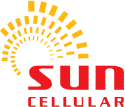
Sun Cellular Mobile Phone Service -Philippines
Sun Cellular website
GSM Frequency Band - 1800 MHz (Single Band)
3G Frequency Band W-CDMA (UMTS) 850Mhz/1900Mhz/2100 MHz
UMTS/3G 1900(uplink)/2100(downlink) (Dual Band)
4G (live LTE, WiMAX, HSPA+)UMTS Frequency Bands for Philipines Phone Apps to Locate Cell Towers

OpenSignal for Android
OpenSignal for iPhone
-
-
I live close to a phone tower but get poor signal.. whats with that?
I live close to a phone tower but get poor signal.. whats with that?-
Why do I get poor signal from the mobile phone tower located just next door.
There's a number of reasons why this could happen. Most commonly, the problem is to do with the characteristics of the antenna on the phone tower.
Your location may be higher or more commonly, lower than the direct horizontal signal path from the cell tower antenna. Cell Tower antennas have a very narrow beam-width to enable the signal to reach a long distance. While the design tries hard to distribute the signal equally to all locations, this is often difficult to achieve, with some customers very close the tower missing out on signal.
The further you are from the tower, the lower the signal strength. As you get closer, the signal strength normally increases. Counteracting this, is the reduction of transmitted power available as your vertical angle becomes more accute. Full Signal Within +/- 7° of Tower Height Good Signal Poor Signal Medium Distance Close to Tower
H = Tower Height
Above Ground
(AGL)
-
Boosters and Repeaters and Smart Antennas
-
Are Mobile Phone Boosters legal in Australia ?
Are Mobile Phone Boosters legal in Australia ?-
Legal Boosters
There are currently only a few models of signal booster that may legally be used in Australia. One model approved by the telco's is the "Cel-fi Repeater".
Cel-fi PRO Repeater for Telstra (aka Smart Antenna) Optus and Vodafone
These boosters are legal because they have passed the criteria required to ensure that their use will not affect other cell phone users. Put simply, the Cel-fi is not just a signal booster, but an intelligent mobile phone device in its own right.
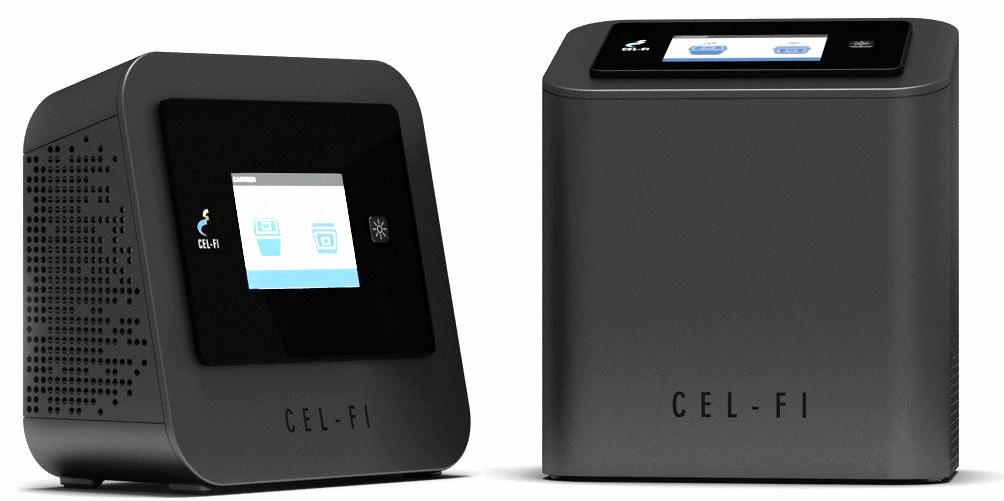
Just like your modem or mobile phone device, the Cel-fi device actively communicates with the cell tower. The tower measures the power of the signal coming the Cel-fi transmitter and sends commands that adjust the power output. The cell tower is in control of the Smart Antenna's power output. Of course its much more complicated than just that, but this is primarily the reason why these boosters are legal. The Cel-fi Smart Repeater has the ability to attach an external Antenna to further increasing the quality of the mobile phone connection.
Full details and specifications for the legal Mobile Phone repeaters are available here.
Why are boosters illegal in Australia ?
The ACMA has declared mobile phone boosters as a prohibited piece of customer equipment under the Telecommunications (Prohibition of Mobile Phone Boosters) Declaration 2011.
A quick search of the web will reveal that there are more than one 3G, GSM and 4G boosters available. Some are on eBay and others are offshore ".com" websites. These sellers don't tell their customers that if they use these boosters in Australia they will be breaching the Radio-telecommunications Act 1992. Also, Australia has significant Consumer Protection laws against sellers intentionally misleading their customers. Thus you'll notice that the above website is not end with ".com.au" meaning that this is not an Australian website.Active Boosters are illegal in Australia for very good reasons.
- All devices that transmit on the Australian mobile phone frequencies require licensing by the ACMA:
- Certification of devices to meet criteria such as Harmonic distortion, interference to adjacent channels and power output to name just a few.
- Determine that the device will operate within the regulations laid out for the Australian Radio-frequency Spectrum.
- Feedback from poorly installed boosters can make the RF stages unstable, causing transmission of very high power RF on the 3G network bands.
The cell tower will lower its power output automatically in response to seeing high power "handheld" signals.- As a result all other customers that normally use this tower will be affected by lower signal strength and less ability to connect to the affected tower.
- There are a number of Emergency services using similar services on adjacent RF bands. An unstable repeater can generate spurious emissions, not only on the intended 3G frequencies but across a very wide range, effecting emergency service communications as well as other 3G phone users.
- Local signal nulls and interference to neighbouring services.
- Signal Nulls can be created due to the fact that the same Cell ID is being re-transmitted at a second location, creating "interference bands".
What happens if I get caught using an illegal booster ?
The maximum penalty for operating an unlicensed transmitter, in this case an illegal 3G Signal Booster, in Australia is $250,000.00 or up to two years imprisonment.
The ACCC has recently announced that it intends to increase the powers of Australian Customs to confiscate and fine those importing illegal signal boosters into Australia.How can Telco's tell that someone is using an illegal booster ?
Any telco can easily track down the source of transmitters that are interfering with cell tower operation. With today's technology the software that runs the cell phone system simply logs the data to a report.
The technician will have in a matter of seconds, all the information needed to pinpoint the exact location of the interference based on triangulation between sectors and time domain measurements between the tower and the devices attached to the booster. - All devices that transmit on the Australian mobile phone frequencies require licensing by the ACMA:
-
-
Do I need to boost the 3G signal or 4G signal ?
Do I need to boost the 3G signal or 4G signal ?-
If not so concerned about data but more so just reliable mobile phone reception, it is best to focus on getting the best 3G signal possible, for several reasons:
- Your mobile will normally default to 3G for voice/sms even if it shows the 4G icon on the screen.
- 3G voice quality is normally better than VoLTE.
- If the Cel-fi is repeating 4G, your Modem(s), and maybe your neighbour's modem may connect to the tower via your Cel-fi rather than directly. 4G data via the Cel-fi is much slower compared to the speed the modem can achieve by connecting directly to the tower via it's own antenna system.
- VoLTE quality and 4G data speed is further reduced proportional to the number of calls and device connections via the Cel-fi.
-
Phone Diagnostics and Settings
-
iPhone Field Test
iPhone Field Test-
How to access the Apple iPhone Field Test mode.
To check which band your iphone is using:
- Dial *3001#12345#*
Note that you can put this number into the contacts list but you cant dial it from there. You'll need to copy-paste it to the keypad.
Which Band or Frequency is your phone is using.
The Downlink and Uplink Frequency data shows a code that represents the exact frequency that your phone is currently using for its Voice and Data connection. While in the Field Test Mode:
- Select UMTS Cell Environment.
This is for 3G connection info, the GSM Cell Environment is useful only when connected to a GSM or EDGE service. - Select UMTS RR Info.
- On this screen you'll see the 3G info. Scroll down until you see the Downlink Frequency or Uplink Frequency line.
- Enter the Uplinlk and Downlink codes into the calculator below.
Find the Cell Tower MCC, LAC and Cell ID your phone is connected to.
The Cell ID, Location Area Code (LAC) and Mobile Country Code (MCC) can usfull in diagnosing connection problems.
- Select UMTS Cell Environment.
- Select UMTS RR Info.
- Scroll down until you see the Cell ID line. It will be a hexidecimal number like "af0f4aa"
- Go back to Field Test main screen.
- Select MM Info.
- Select Serving PLMN.
- Here is displayed the Cell ID, Location Area Code and Mobile Country Code
References:
Field Test Codes for many other phones here:
https://www.unwiredsignal.com/data/shopcart7/content_db/Phone-Test-Modes1.pdf
UMTS frequency/bands:
- Dial *3001#12345#*
-
Payment, Shipping and Refunds
-
Can I pickup from your store ?
Can I pickup from your store ?-
Sorry, No. We are an online store only and do not offer a pickup service to any of our customers. To keep our prices so competitive, we do not have the overhead costs of a storefront, shipping direct from our own warehouse located in Macclesfield, South Australia, with some items shipped directly from our suppliers warehouses located in QLD, NSW and VIC. We ship worldwide every business day.
-
-
How to Pay your Order or Quotation
How to Pay your Order or Quotation-
How to pay (re-pay) for your Quotation or Order The following instructions are useful when:
- Your order payment method failed,
- You changed your mind on how you'll pay for your order or
- You have accepted a quotation and wish to formalize the order.
1. Sign in to your account: 
2. Select your order: 
3. Select your payment method:
4. Click "Pay order"

Please Contact us immediately with any questions.
To print a PDF version of the order: Sign-in into your account, select the order then press
For Direct Bank Payment:
Please Copy and Paste the bank account details shown at the bottom this invoice when making an internet banking transfer.
If you've already make the payment by bank deposit, please check your bank account statement to confirm details.
If you've already paid by PayPal or Credit Card, please Contact us and we will check the status of the order. - Your order payment method failed,
-
-
Shipping, when will my order arrive ?
Shipping, when will my order arrive ?-
Shipping and Handling
Orders shipped by standard post are dispatched within 2 business days, (most often the same day) after receipt of payment.
Express Post items are dispatched same business day if ordered before 2:00PM South Australian time.
Orders are shipped by Australia Post eParcel or Express eParcel with the exception of items shipped directly from our other warehouse(s).
Shipping fees include handling and packing fees as well as postage costs. Handling fees are fixed, whereas transport fees vary according to total weight and/or volume of the shipment.Grouping of Multiple Orders
We advise you to group your items in one order. We normally do not group multiple distinct orders placed separately, and shipping fees will apply to each of them.
Very special care is taken to protect all items during packaging. Boxes are amply sized and your items are well-protected.Shipment Cost Estimate
To calculate exact shipping costs, add your items to the cart, then proceed to checkout, all the costs are shown prior to finalising your order. Use the Shipping Estimator to calculate your shipping costs.Delivery Times
Delivery time is dependant upon your location.
Where applicable *Unless stated otherwise in the Product Description:
Express eParcel: - 1-4 business days if ordered before 2pm Monday to Thursday ,
eParcel Parcel Post: - 1-7 business days if ordered before 2pm Monday to Thursday.
Australia Post does not deliver on weekends. Orders placed over the weekend or on public holidays will be dispatched on the next business day with normal delivery times applicable.Delivery Tracking
eParcel Parcel Post has Tacking Number.
Express eParcel has Tacking Number.
Regular Post does not include insurance nor trace-ability.Shipping Disclaimer & Liability
Should you have any problems resolving delivery of your order, please contact us via the Start Communication link shown on your order details page.
If your delivery is not received within the times specified above, copy the tracking number from the invoice or eBay sales record and paste it into the Australia Post Parcel Tracking page. If goods are physically damaged upon delivery, please lodge a formal claim with Australia Post immediately, before leaving the Post Office.
REMOTEONE take no responsibility for non-delivery of, or damage to items once they are handed over to Australia Post. We will not be held liable for losses incurred against items that have been shipped but not delivered.
-
-
Refunds and Terms of Supply
Refunds and Terms of Supply-
Address your order carefully.
We ship worldwide to PO boxes, business and street addresses. Please ensure that your suburb/city exactly match your postcode. We take no responsibility for lost or delayed delivery due to an incorrect or ambiguous shipping address.
- Orders returned to us as undeliverable require payment of normal shipping costs to re-deliver.
- &&Undeliverable orders returned to us due for a refund will be subject to the usual re-stocking fee detailed below.
- Under no circumstances is the original shipping cost refundable.Conditions of order
We advise you to group your items in one order. We do not group two distinct orders placed separately, and shipping fees will apply to each of them.Shipping Disclaimer & Liability.
If consignment is not delivered within the times specified above, please contact the shipping company directly.1. Browse to the Tracking website for the shipping company.
Australia Post Parcel Tracking
Startrack Courier
TNT Couriers
Toll Couriers
Couriers Please2. Copy the tracking number from the invoice or eBay sales record and paste it into the above tracking page.
Warranty & Returns
We are Australian distributors for all our products and provide full support and warranty for all products via the RMA (Return Merchandise Approval) facility built into our web site. Australian Law provides consumers with standard guidelines for Return Merchandise, please refer to the Office of Business and Consumer Affairs for more information.Refunds
Were a refund (either Partial or Full) is due:
- If you paid for your order via Paypal account or the PayPal credit card payment facility your refund will be transferred using the same account.
- If paid by EFT your refund will be transferred by direct transfer to your account. You may need to supply your account details again.
We do not send refunds via cheque.Dead-on-arrival or faulty items
We will replace and ship any faulty item within its warranty period free of charge.- You must first lodge a RMA Request prior to shipping the item back to us.
- Once we receive the returned item, we will test it for faults or other concerns as discussed.
- If the item is found to be not faulty, performing within advertised specification, we will return the item at the customers expense. In this case shipping costs will apply and must be paid prior to shipping. Non-Faulty item shipping costs can be paid here.
If you have ordered the wrong item or decided that you no longer want the item
Where an order has not yet been dispatched:
We can cancel or adjust your order as per your request. Cancelled orders will be fully refunded.Where an order has been dispatched and delivered parcel is un-opened and/or product is unused:
For wrong-item-purchased or change-of-mind return requests, we offer either:
a. Credit of value equal to the product price for use toward purchase of a more appropriate product.
b. Refund less #Re-stocking Fee on product returned in re-saleable condition.
In either case, the +Conditions of Return Acceptance apply.Where an order parcel has been delivered, opened and used:
We generally do not accept returns for non-faulty, wrong-item-purchased or change-of-mind return requests, where the product has been used, tested or operated.
Exception may be made by consultation where a more appropriate product has been purchased from our store.If an article has been returned to us as undelivered
For any article returned to us by the postal service as being Address Unknown, &&Undeliverable or because it has not been collected from the Post Office or Depot:- The items will be returned to stock until we are contacted by the customer.
- If re-shipping is required, payment of the shipping cost to the (corrected) address is required.
- If no longer required, see conditions above.
Refunds for International orders, customers outside of Australia
For International Shipping addresses (outside of Australian Territory) orders returned to us for &reasons other than faulty returns will not be refunded. At customers request for reshipment, normal shipping costs will be payable to allow re-delivery of your order to your confirmed shipping address.+Conditions of Return Acceptance
- The order balance will be adjusted to reflect the cost of difference of the alternate re-supplied item.
- Any additional payment required must be received before the re-supplied item(s) will be shipped.
- Customer will be responsible for shipping costs of the re-supplied items.
- The original shipping cost will not be refunded.
- We must receive all items that have been approved for return/replacement in perfect un-marked and re-saleable condition.
- ALL original internal plastic, bag and other internal packaging must be returned in perfect condition.
- Copy of the original invoice and/or RMA approval MUST be included.
- ALL items must not be marked, chipped, scratched, dented, bent or altered in any way from its delivered condition.
- ALL Mounting Brackets, U-Bolts, Nuts, Bolts, and other hardware MUST be returned
(unless other arrangement has been agreed). - Product returned with missing or damaged parts will be rejected.
- An RMA (see instructions below) must be lodged and items received in re-sale able and complete condition.
#Restocking Fee
Where applicable, the following fee applies for items ordered by mistake and non-faulty returns.- $10 plus 10% of item total value of items returned..
How to make payment for additional shipping costs and/or item replacement costs
To make a payment for the agreed balance of a replacement item, or return of non-faulty item, where no new order has been generated.- Click here to make payment for the additional costs.
- Enter the agreed price.
- Checkout.
To lodge a Return Merchandise Authorization (RMA) Request
1. Go to My Account.
2. Sign-in to your account.
3. Go to My Account and
Click Orders.4. Select the order in question.
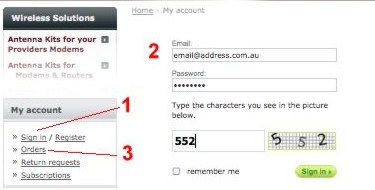

5. Click: Request service or return of a product
6. Enter details & press Return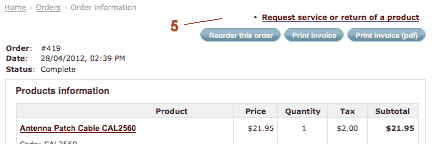
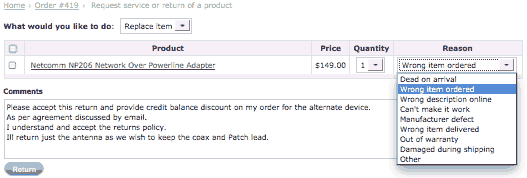
If agreed, we will have you ship the item back to us and inspect its condition etc.
If all is good, we'll notify you of the request approval by email as soon as possible, and arrange any refunds or credit coupons as agreed& "reasons other than faulty returns" means:
Includes , but not limited to:- Items returned without RMA.
- Articles returned by the shipping company as undeliverable.
- Incorrectly ordered products.
- Products with unsuitable specifications for your purpose, but fit-for-purpose as advertised.
- Products returned for testing and confirmed by us as not-faulty.
&& "undeliverable" means:
Include, but not limited to, articles returned to our store by either Australia Post or their nominated partner for the destination country with the following status:- Undeliverable, Return To Sender, Unknown, Refuse Delivery, Unclaimed, Left, Address Incomplete, Distribution Not Allowed or words the same effect.
©
 ABN 866 208 063 99
ABN 866 208 063 99Refunds, Returns and Shipping FAQ page
&&
-
International Shipments
-
International Shipment Terms
International Shipment Terms-
Handling
Packages are generally dispatched within 2 business days after receipt of payment.
Conditions of Order
We advise you to group your items in one order. We cannot group two distinct orders placed separately, and shipping fees will apply to each of them. Special care is taken during when packing to protect items transport. Boxes are amply sized and your items are well-protected.Shipment Cost:
To calculate exact shipping costs, simply log in, add your items to the cart, then proceed to checkout, all the costs are shown prior to finalizing your order. Use the Shipping Estimator to calculate your shipping costs.Restocking Fee
Where applicable, the following fee applies for items ordered by mistake and non-faulty returns.
(unless by other arrangement)- $10 plus 10% of item total value of items returned..
- This fee will never be more than $20 but is rounded up to the nearest $2.
For example, the Restocking fee for a $200 antenna order will be $20. If returning an incorrectly ordered Patch Cable (cost $17.90), the fee would be $12.
Delivery Times:
Where applicable *Unless stated otherwise in the Product Description:
Express Parcel International: - 5-14 business days with Tacking Number.
RegisteredParcel International: - 7-22 business days with Tacking Number.Shipping Disclaimer & Liability.
If your delivery is not received within the times specified above, copy the tracking number from the Invoice and paste it into the Australia Post Parcel Tracking page. If you feel If goods are physically damaged upon delivery, please lodge a formal claim with Australia Post immediately.
We take no responsibility for non-delivery of, or damage to items once they are handed over to Australia Post. We will not be held liable for losses incurred against items that have been shipped but not delivered. However, should you have any problems regarding delivery of your order, please contact us via the Start Communication link shown on your order details page.Dead-on-arrival or faulty items:
We will replace and ship any faulty item within it warranty period free of charge.
Please lodge a RMA Request prior to shipping the item back to us.If you have ordered the wrong item or decided that you no longer want the item:
- If we are notified before the item has been shipped we will provide a full refund without fees.
- If already shipped prior to notification, we cannot alter the order nor provide any refund.
If an article has been returned to us as undelivered:
If the postal service returns any article to us as being address unknown, undeliverable or because it has not
been collected from a Postal Office or Depot:- The items will be returned to stock until we are contacted by the customer..
- If re-shipping is required, payment of the shipping cost to the (corrected) address is required.
- If no longer required, our standard re-stocking fee (see above) will be deducted from any applicable refund.
- An RMA (see instructions below) must be lodged and items received in re-sale able and complete condition.
How to make payment for additional/resupply shipping costs and/or item replacement costs
To make a payment for the agreed balance of a replacement item, or return of non-faulty item, where no new order has been generated.- Click here to make payment for the additional costs.
- Enter the agreed price.
- Checkout.
As soon as we have recieved the payment , we will re-ship your item.
-
References and Footnotes
-
Information links.
Information links.-
Footnotes:
1. At time of writing. Subject to change without notice as new services are introduced.
2. Speeds are general, and either theoretical maximums, or carrier advertised speeds, intended as a guide only.
3. Some devices do not support maximum service speed.
For example many devices operating on the 14Mbps HSPA service are capable of only 7.2Mbps DL speed.
Devices such as the ZTE MF91, are capable of only 21MB/s DL on the HSPA+ network.
4. Rounded to nearest decimal point. Some areas have wider bandwidth than others, covers worst case.
5. Slant Polarised antennas consist of two separate antenna.
One antenna being "tilted at -45º and the other a +45º from vertical.
Towers supporting Antenna Diversity, Dual Carrier and/or MIMO systems.
6. In some areas the Telstra coverage map shows "4G" service where there is no 4G LTE 1800.
The service is instead a 3G DC-HSPA+ service with a fast back-haul speed,
capable of up to 40Mbps download.
7. Backhaul Data Rate is the maximum rate that data can be supplied to a cell tower node by the
carrier's microwave, fiber data link infrastructure.References: Amended with relevance to Australian services.
https://en.wikipedia.org/wiki/3G
https://en.wikipedia.org/wiki/UMTS
https://en.wikipedia.org/wiki/HSPA
https://en.wikipedia.org/wiki/3GPP
https://en.wikipedia.org/wiki/W-CDMA
https://en.wikipedia.org/wiki/Dual-Carrier_HSPA
https://en.wikipedia.org/wiki/E-UTRA
https://web.archive.org/web/20130718153346/https://en.wikipedia.org/wiki/E-UTRA
https://whirlpool.net.au/wiki/mobile_phone_frequencies
https://en.wikipedia.org/wiki/4G_Australia
https://engage.acma.gov.au/digitaldividend/wp-content/uploads/2013/05/figure-3_final.pdf
-
HelpDesk - Contact Us
-
Contact us - for location specific and installation advice
Contact us - for location specific and installation advice-
Many common questions have been answered on our Frequently Asked Questions page.
Please select the appropriate contact link below.Contact us links
Our preferred communication method is via the applicable contact forms linked below.
We do not publicly share any information you enter in the form. We do not spam you with sales letters or emails, nor will we post your information on any blog or forum. These forms are encrypted and secured by SSL (https) certificate.Questions Regarding Your Order
*Need to change, update shipping method or just have a question about your order, please use our Order Communication system.
Order Tracking
*Your order tracking reference/link was included with the Tax Invoice notification email.
Tracking can also be viewed from your Order Details page.
Troubleshooting
*For troubleshooting advice use our Installation Troubleshooting form.
Pre-order Advice
*For antenna recommendations use our Antenna Recommendation Request form.
General Questions
*For other advice use our general Contact Us form.
FAQ - Shipping, Returns, Terms and Conditions
*Please see our FAQ pages for detailed info FAQ form.
-
-
General discussion
General discussion
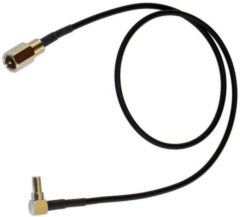
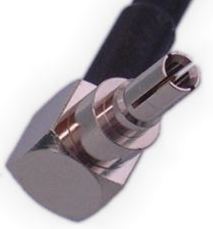 You can still use a passive cradle in situations, such as motor vehicles, where the phone will be moved often.
You can still use a passive cradle in situations, such as motor vehicles, where the phone will be moved often.